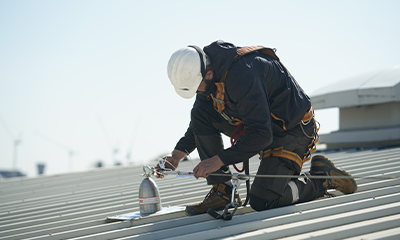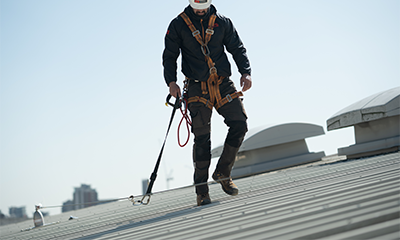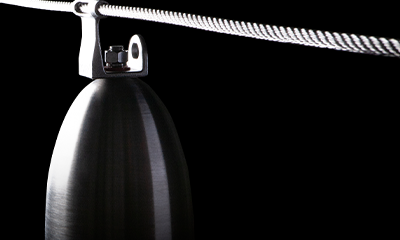The correct fall protection system
Is your chosen fall protection safety system actually suitable for the roof structure it's attached to?
Written by James Gooder, Business Unit Manager - Fall Protection.
Recent results generated from our test facility provide great examples of the forces generated during the event of a free fall from height.
All anchor devices used in horizontal lifeline safety systems rely on the strength of the substrate to which they are attached and the fastening elements chosen for the application. The anchor device alone is not enough. This is due to the forces generated in a free fall event, which will transfer through the system and into the roof structure.
A building owner, system designer or specialist installer needs to question whether the system will protect the roof structure and save the users life. If not, the forces could be too much for the roof structure, causing the system to detach from the substrate with potentially devastating consequences.
The first graph, see below, highlights the force that generated by a 200kg mass free falling over a measured distance and impacting on a rigid anchor device that is secured to concrete.

Graph 1
This dynamic test, is a system calibration performed in accordance with the requirements of CEN/TS 16415:2013, the multi-user standard that supports EN 795:2012 for personal fall protective equipment - anchor devices.
What we can see in this graph is that the initial peak is followed by a series of decaying peaks as the mass comes to rest.
In each case these peaks represents a force that are all greater than that of the mass on a static condition hanging from the lifeline.
What we can see in this graph is that the initial peak is followed by a series of decaying peaks as the mass comes to rest.
In each case these peaks represents a force that are all greater than that of the mass on a static condition hanging from the lifeline.
The second graph highlights the performance of a load-limiting SOTER II post module when subjected to the same dynamic performance tests as conducted in the calibration.
Here you can see that the 12kN force generated due to the mass free falling is reduced to half of that which was measured during calibration test. The graph shows an initial spike which is limited to 6kN, our design intent. We can also observe that the internal absorber deployment has slowed the mass bringing it gently to rest.
This can be identified by the trace resting at circa 2kN, representing the 200kg mass hanging on the deployed post module. We can conclude from these results that the system and fasteners are suitable for the application we have tested, in this case a 0.7mm steel deck.
Results like this are a definitive way of confirming suitability of an anchor device in application, something the current standards do not make a requirements for. EN 795:2012 and CEN/TS 16415:2013 do not cover any of the application requirements, they are essentially product standards.
It is entirely possible for an anchor device that has only been tested on a concrete deck to be sold for an application that potentially has a weaker substrate. It is therefore vital that a manufacturer provides applications based results for every given roof substrate, such as 0.7mm metal composite panel or a 20mm OSB deck, to prove compatibility.
Here you can see that the 12kN force generated due to the mass free falling is reduced to half of that which was measured during calibration test. The graph shows an initial spike which is limited to 6kN, our design intent. We can also observe that the internal absorber deployment has slowed the mass bringing it gently to rest.
This can be identified by the trace resting at circa 2kN, representing the 200kg mass hanging on the deployed post module. We can conclude from these results that the system and fasteners are suitable for the application we have tested, in this case a 0.7mm steel deck.
Results like this are a definitive way of confirming suitability of an anchor device in application, something the current standards do not make a requirements for. EN 795:2012 and CEN/TS 16415:2013 do not cover any of the application requirements, they are essentially product standards.
It is entirely possible for an anchor device that has only been tested on a concrete deck to be sold for an application that potentially has a weaker substrate. It is therefore vital that a manufacturer provides applications based results for every given roof substrate, such as 0.7mm metal composite panel or a 20mm OSB deck, to prove compatibility.

Graph 2
Fall Restraint and Fall Arrest Systems
A fall restraint system is a personal fall protection solution that is designed to control a user's position or route on a roof or at height application. With this system, a user is restrained from accessing areas where a fall could occur, such as roof edges or sky lights.
Restraint systems can vary can vary in type, including single point anchors classified as Type A devices or horizontal lifelines classified as Type C anchor systems. Both these systems require personal protective equipment (PPE) including a full body harness and shock absorbing lanyard when accessing systems.
Fall arrest systems utilise the same single point anchors or horizontal lifelines as a restraint system, but the user's position or route dictate that the chances of a fall are unavoidable. Good practice tells us that fall arrest systems are the last resort where no other option is available. In this instance risk assessments and method statements would detail the extra previsions required to bring the user to safety should a fall occur.
FAQs
How is work at height defined?Any place where if precautions were not taken, a person could fall a distance liable to cause personal injury.
What type of roof surfaces are there where a fall protection system is in place?
Flat roof systems, metal roof systems both typically commercial buildings. This can be extended to green roofs, blue roofs, inverted roof, standing seam roofs and composite metal panels.
What Qualifies as a Safety Anchorage Point For a Personal Fall Arrest System?
An anchor point as defined by EN 795:2012.
What Is an Anchorage for Fall Protection?
An anchor device designed for the attachment of components of a personal fall protection system in accordance with EN 363.
How do you identify hazards through planning?
Identify the hazards, skylights, piping, ducting and wire trays, roof edges, gutter lines, solar and PV arrays, HVAC equipment, roof vents.
You might also like

Fall Protection Whitepaper

 English (Canada)
English (Canada)
 čeština (Česká republika)
čeština (Česká republika)
 magyar (Magyarország)
magyar (Magyarország)
 Deutsch (Deutschland)
Deutsch (Deutschland)
 eesti (Eesti)
eesti (Eesti)
 español (España)
español (España)
 português (Portugal)
português (Portugal)
 English
English
 suomi (Suomi)
suomi (Suomi)
 français (France)
français (France)
 italiano (Italia)
italiano (Italia)
 Nederlands (Nederland)
Nederlands (Nederland)
 norsk, bokmål (Norge)
norsk, bokmål (Norge)
 polski (Polska)
polski (Polska)
 svenska (Sverige)
svenska (Sverige)
 Türkçe (Türkiye)
Türkçe (Türkiye)



